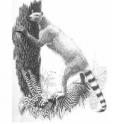Fossil shelved for a century reworks carnivore family tree
More than a hundred years after its discovery, the limbs and vertebrae of a fossil have been pulled off the shelf at the American Museum of Natural History to revise the view of early carnivore lifestyles. Carnivores—currently a diverse group of mostly meat-eating mammals like bears, cats, raccoons, seals, and hyenas—had been considered arboreal in their early evolutionary history. But now that the skeleton of 'Miacis' uintensis has been unpacked from its matrix of sandstone, it is clear that some early carnivores were built to walk on the ground at least part of the time. The new research is published this month in the Journal of Vertebrate Paleontology. "Carnivores are highly varied today, and they were also very diverse in the past," says lead author Michelle Spaulding, a doctoral candidate at Columbia University and the Museum. "Examination of this fossil tells us that they were not all sitting in trees, looking down. 'M.' uintensis did not have a lot of adaptations for an arboreal lifestyle."
"It is typically thought that the miacoids of the Eocene—the basal fossil relatives of modern Carnivora that root the family tree—were arboreal," concurs co-author John Flynn, Frick Curator of Fossil Mammals at the Museum. "But we now are beginning to see that there was a greater diversity of locomotor styles in early carnivores."
'M.' uintensis was discovered on an American Museum of Natural History expedition in 1894 among the brown and red sandstones of the White River beds in Utah. Paleontologist Henry Fairfield Osborn, who first named the iconic dinosaurs Tyrannosaurus rex and Velociraptor mongoliensis, described the teeth of the newly discovered mammal carnivore species in a Museum monograph the following year. The specimen dates to 39-42 million years ago.
But the species is more than teeth and a jaw. Another specimen found in 1896 is more complete, represented by much of the skull, shoulder bones, limb bones, and even some tiny foot and finger bones. This specimen remained on a shelf in the Museum, largely ignored, because its teeth were badly crushed.
"When I examined the femur, I immediately knew this was a terrestrial animal because of the shape of its knee. It has a long and deep groove where the patella, or kneecap, would go," says Spaulding. If the early carnivore had been exclusively arboreal, the end of the femur would have had a flatter surface so that the joint would have a greater range of motion. Spaulding and Flynn found other indicators of terrestrial locomotion on bones like the radius, one of the two lower arm bones. The distal part of the radius, or the portion of the bone that would be in contact with the wrist, of 'M.' uintensis has an oval shape with a projection above the rim. These features also reduce the range of motion, making limbs more stable for walking on the ground. Other features, however, indicate that 'M.' uintensis had some adaptations for climbing, so this early carnivore was most likely flexible in locomotion style, active mostly on the ground but also capable of climbing bushes and trees.
This analysis is the fifth time that early carnivore postcrania have been carefully described in detail. Adding the information from this long-neglected fossil to the previously known data, though, does point researchers into new directions. An analysis of 99 traits among 29 fossils and 15 living taxa resulted in a new evolutionary tree that shows that 'M.' uintensis is distantly related to the type specimens from the Miacis genus, suggesting that an extensive revision of the current understanding of the evolutionary relationships among early carnivore fossils may be needed. But more significantly, the structure of the evolutionary tree suggests that adaptations to terrestrial or semi-terrestrial locomotion were more common than previously suspected in early fossil carnivores, preceding the split between the two major groups of living Carnivora, the Caniformia (a group that includes dogs, weasels, bears, seals and their relatives) and Feliformia (cats, hyenas, mongooses and civets).
"The fossil that we re-describe was thought to be in poor condition and had been ignored," says Flynn. "But now we are beginning to gain a better understanding of the ancestral conditions near the base of the carnivore tree. A lot of skeletons have been found over the years, and we think that intensively studying additional fossils will help build a more comprehensive view of the habitat-specializations of the early relatives of the living Carnivora."
Source: American Museum of Natural History
Other sources
- Fossil shelved for a century reworks carnivore family tree: Limbs changes understanding of early carnivore locomotionfrom Science DailyWed, 23 Dec 2009, 1:14:23 UTC
- Fossil shelved for a century reworks carnivore family treefrom PhysorgTue, 22 Dec 2009, 19:14:20 UTC
- Fossil shelved for a century reworks carnivore family treefrom Science BlogTue, 22 Dec 2009, 16:35:52 UTC
